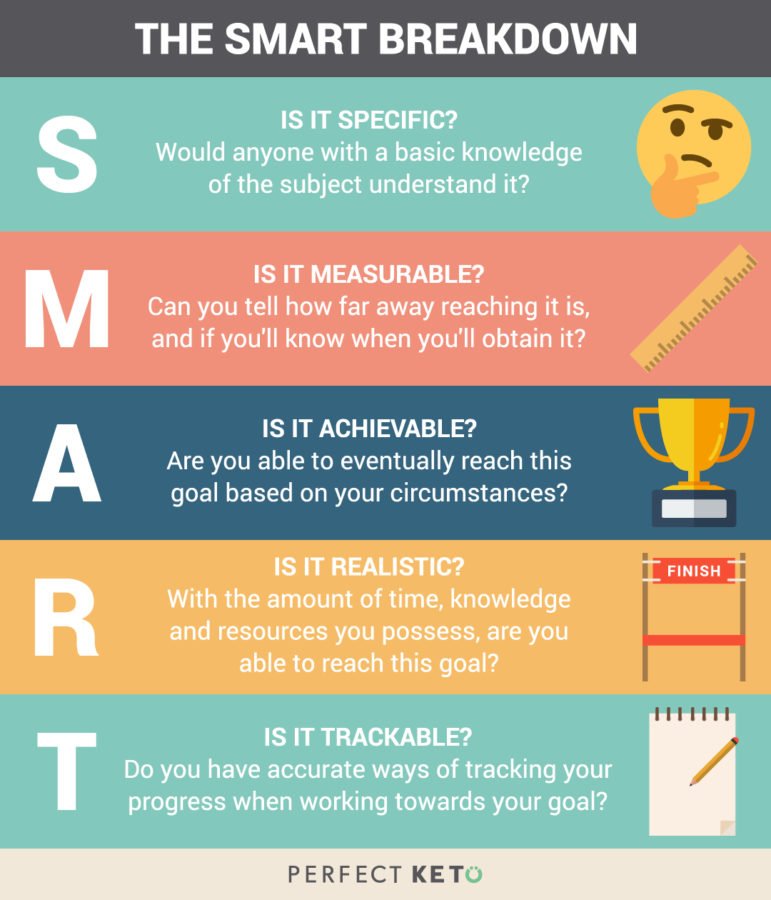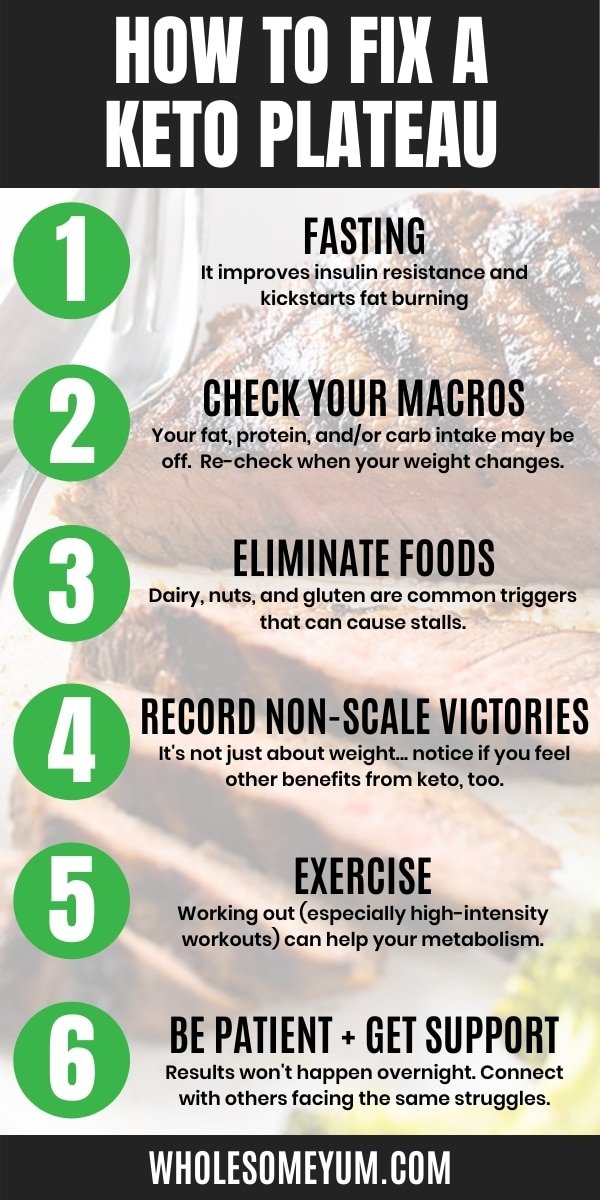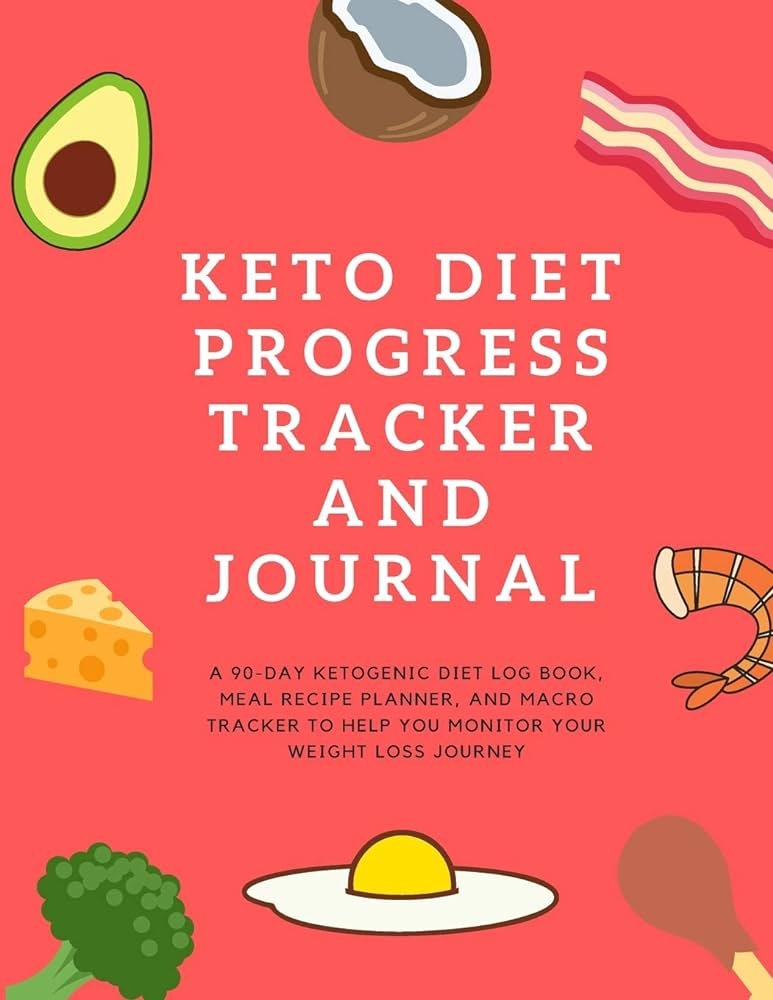If you’re on the Keto diet and want to effectively track your weight loss progress, it’s important to find a method that works for you. Keeping tabs on your progress can provide motivation and help you stay on track. Whether it’s through measuring your body, logging your food intake, or using technology, there are various strategies you can employ to track your weight loss journey on the Keto diet. In this article, we’ll explore some effective methods to help you monitor your progress and reach your goals.

This image is property of perfectketo.com.
1. Set Realistic Goals
Setting realistic goals is essential for tracking your weight loss progress on the keto diet. It’s important to determine your target weight and break it down into smaller milestones. This will make your weight loss journey more manageable and help you stay motivated along the way. Additionally, setting a timeline for each milestone will give you a clear sense of direction and help you stay on track.
1.1 Determine your target weight
Before you can effectively track your weight loss progress, you need to establish your target weight. This should be a realistic and attainable goal that aligns with your overall health and well-being. Consider factors such as your body type, height, and any underlying health conditions. Consulting with a healthcare professional or registered dietitian can provide valuable guidance in determining a healthy target weight for you.
1.2 Break it down into smaller milestones
Once you have determined your target weight, it’s important to break it down into smaller, more achievable milestones. Losing a large amount of weight can feel overwhelming, but breaking it into smaller chunks will make the process more manageable and less daunting. Aim to set milestones that are attainable within a specific timeframe, such as losing 1-2 pounds per week. This will provide you with a sense of accomplishment and keep you motivated on your weight loss journey.
1.3 Set a timeline for each milestone
Setting a timeline for each milestone is crucial for tracking your weight loss progress effectively. It helps to establish a clear roadmap and gives you a sense of urgency. When setting timelines, consider factors such as your current weight, desired rate of weight loss, and any upcoming events or special occasions. However, it is important to prioritize your overall health and well-being over achieving rapid weight loss. Remember, slow and steady wins the race.
2. Use a Scale to Track Progress
Using a scale is one of the most common and convenient ways to track your weight loss progress. It provides you with concrete data to monitor your success on the keto diet. However, it’s important to use a reliable scale and follow a consistent weighing routine to get accurate and meaningful results.
2.1 Choose a reliable scale
Selecting a reliable scale is essential for accurate weight tracking. Consider investing in a digital scale that provides consistent and precise measurements. Look for features such as high accuracy, a large and easy-to-read display, and the ability to store data for multiple users. Reading reviews and seeking recommendations can help you make an informed decision and choose a scale that meets your needs.
2.2 Weigh yourself at the same time each day
For consistent and reliable measurements, it’s crucial to weigh yourself at the same time each day. Ideally, weigh yourself in the morning after emptying your bladder and before eating or drinking anything. This will ensure that variables such as food intake and hydration levels do not affect your weight readings. By following a consistent weighing routine, you can track your progress accurately and identify trends over time.
2.3 Track your weight on a consistent schedule
In addition to weighing yourself at the same time each day, it’s important to establish a consistent schedule for tracking your weight. Decide on a frequency that works for you, whether it’s daily, weekly, or biweekly. Stick to this schedule and record your weight in a notebook, spreadsheet, or a weight tracking app. This will enable you to visualize your progress and identify any plateaus or fluctuations in your weight loss journey.

This image is property of www.wholesomeyum.com.
3. Measure Body Composition
Tracking body composition is an important aspect of monitoring your weight loss progress on the keto diet. While weight alone cannot provide a complete picture of your overall health and body composition, there are various methods you can use to gain insights into changes in your muscle mass and body fat.
3.1 Use a body fat caliper
A body fat caliper is a simple and inexpensive tool that can provide an estimate of your body fat percentage. By pinching different skinfold sites with the caliper, you can measure the thickness of the folds and use a formula to calculate your body fat percentage. While this method may not be as accurate as other advanced techniques, it can still be useful for tracking changes in body fat over time. Make sure to follow proper techniques and consult resources or professionals for guidance on how to use a body fat caliper correctly.
3.2 Consider other methods of measuring body composition
In addition to using a body fat caliper, there are other methods available for measuring body composition, such as bioelectrical impedance analysis (BIA), dual-energy X-ray absorptiometry (DXA), and air displacement plethysmography (ADP). These methods provide more precise measurements of body fat percentage, muscle mass, and other valuable insights. Consulting with a healthcare professional or registered dietitian can help you determine which method is most suitable for your needs and goals.
3.3 Track changes in muscle mass and water weight
While tracking changes in body fat percentage is important, it’s equally crucial to monitor changes in muscle mass and water weight. The keto diet can lead to changes in water retention and muscle mass due to reduced carbohydrate intake. By keeping track of these changes, you can have a more comprehensive understanding of your body’s transformation. However, it’s important to note that fluctuations in muscle mass and water weight may not always be reflected on the scale. Utilize a combination of body composition measurements, such as body fat calipers and measurements of different body areas, to gain a holistic view of your progress.
4. Take Before and After Photos
Taking before and after photos is an effective way to visually track your weight loss progress on the keto diet. While the scale and body composition measurements provide numerical data, photos can capture the physical changes you’ve experienced. By following a few simple guidelines, you can create a compelling visual record of your transformation.
4.1 Capture your starting point
At the beginning of your weight loss journey, take a set of “before” photos to capture your starting point. This will serve as a reference point for later comparison. Take photos from different angles, including front, side, and back views. Wear form-fitting clothing or swimwear to highlight your body’s contours. Additionally, consider taking measurements of different body areas, such as waist, hips, and thighs, to track changes beyond what photos can capture.
4.2 Use consistent lighting and angles
To ensure accurate and meaningful comparisons, use consistent lighting and angles for your before and after photos. Natural daylight or well-lit indoor spaces provide the best lighting conditions. Avoid dramatic shadows or harsh lighting that can obscure details. Position yourself in the same location, and use markers or reference points to maintain consistent angles and poses. This will provide a clear visual representation of your progress and eliminate any discrepancies due to lighting or posing variations.
4.3 Compare photos to track visual progress
After a period of time, take another set of photos to compare with your before photos. Align the images side by side or overlay them to observe the changes in your physique. Look for noticeable differences in body shape, muscle definition, and overall appearance. Celebrate the progress you have made, and use these visual reminders to stay motivated and continue on your weight loss journey.

This image is property of Amazon.com.
5. Keep a Food Diary
Keeping a food diary is an excellent way to track your dietary intake and monitor your progress on the keto diet. By recording everything you eat and drink, you can gain valuable insights into your macronutrient ratios, portion sizes, and overall adherence to the keto guidelines.
5.1 Record everything you eat and drink
To maintain an accurate food diary, make it a habit to record everything you consume throughout the day. Include detailed information such as the type of food, portion size, cooking methods, and any condiments or additives used. Be consistent and diligent in your tracking, as even small bites or snacks can add up and affect your progress. By having a comprehensive record of your dietary intake, you can identify patterns, make adjustments, and stay accountable to your goals.
5.2 Track macronutrient ratios
One of the key factors of the keto diet is maintaining specific macronutrient ratios, typically high fat, moderate protein, and low carbohydrates. Keeping track of these ratios in your food diary is crucial for achieving and sustaining a state of ketosis. Use a nutritional tracking app or consult resources to determine the macronutrient composition of different foods. Aim to stay within the recommended ranges to promote fat burning and maximize the benefits of the keto diet.
5.3 Monitor portion sizes
In addition to tracking macronutrient ratios, monitoring portion sizes is important for weight loss on the keto diet. Even though the focus is on high fat foods, consuming excessive calories can hinder progress. Use measuring cups, a food scale, or visual cues to estimate portion sizes accurately. Be mindful of hidden sources of carbohydrates and added sugars that can sneak into your meals. By monitoring portion sizes and being aware of your calorie intake, you can optimize your weight loss efforts on the keto diet.
6. Monitor Ketone Levels
Monitoring ketone levels is a critical aspect of tracking your progress on the keto diet. Ketones are produced by the liver when your body breaks down fat for energy in the absence of carbohydrates. By measuring ketone levels, you can ensure that you are in a state of ketosis and optimize your body’s fat-burning capabilities.
6.1 Test for ketones in your urine
Testing for ketones in your urine is one of the easiest and most affordable methods to monitor your ketone levels. Ketone test strips, available in most drugstores or online, can quickly assess the presence of ketones in your urine. However, it’s important to note that these test strips primarily measure excess ketones that your body is not utilizing, rather than the actual ketone levels in your bloodstream. While easy to use, urine tests may not provide the most accurate representation of ketosis, especially as your body becomes more efficient at utilizing ketones over time.
6.2 Use a blood ketone meter for more accurate results
For a more accurate assessment of your ketone levels, consider using a blood ketone meter. This device measures the actual levels of beta-hydroxybutyrate (BHB) ketones in your bloodstream. By pricking your finger and placing a small amount of blood on a test strip, you can obtain precise ketone level readings. Blood ketone meters are more costly than urine test strips, but they provide a more accurate measurement of ketosis and can be a valuable tool for tracking your progress on the keto diet.
6.3 Track changes in ketone levels over time
Regardless of the method you choose to monitor ketone levels, it’s important to track changes over time. Document your readings in a logbook or tracking app to observe trends, fluctuations, and any patterns related to your dietary choices or lifestyle factors. By tracking your ketone levels, you can make adjustments to your diet and ensure that you are staying in the desired state of ketosis. Remember that individual responses to the keto diet may vary, and it’s important to find the level of ketosis that works best for your goals and overall well-being.

This image is property of cdn.ruled.me.
7. Pay Attention to How You Feel
While numerical data and measurements are essential for tracking your weight loss progress on the keto diet, paying attention to how you feel is equally important. The keto diet can have profound effects on your energy levels, mood, mental clarity, and overall well-being. By tracking these subjective changes, you can gain insights into the non-quantifiable aspects of your transformation.
7.1 Note changes in energy levels
One of the significant benefits of the keto diet is an improvement in energy levels. As your body adapts to using fat as its primary fuel source, you may experience increased energy and sustained stamina throughout the day. Pay attention to how your energy levels fluctuate throughout the duration of your weight loss journey. Note any significant improvements or fluctuations and adjust your diet and lifestyle accordingly to optimize your energy levels.
7.2 Monitor mood and mental clarity
The keto diet has been associated with improvements in mood stability and mental clarity for many individuals. Ketones, the byproduct of fat metabolism, provide an alternative source of fuel for the brain, which may lead to enhanced cognitive function. Monitor your mood and mental clarity as you progress on the keto diet. Be mindful of any changes in focus, concentration, or overall mental well-being. Use these subjective observations to gauge the impact of the diet on your cognitive function and make any necessary adjustments.
7.3 Track any improvements in health conditions
In addition to monitoring energy levels, mood, and mental clarity, pay attention to any improvements in pre-existing health conditions or symptoms. Many individuals have reported positive changes in conditions such as insulin resistance, type 2 diabetes, and polycystic ovary syndrome (PCOS) while following the keto diet. Note any changes in symptoms, medication requirements, or laboratory test results. Consult with your healthcare provider to assess the impact of the diet on your specific health conditions and make any necessary adjustments.
8. Measure Inches Lost
In addition to tracking your weight and body composition, measuring inches lost can provide further insights into your progress on the keto diet. While weight alone may not always accurately reflect changes in body composition, measuring different body areas can provide a more comprehensive view of your transformation.
8.1 Take measurements of different body areas
To measure inches lost, use a tape measure and record the circumferences of different body areas such as waist, hips, chest, arms, and thighs. Be consistent in your measuring techniques to ensure accurate and meaningful comparisons. Take measurements regularly, such as every two weeks or once a month, to track changes over time. Remember that inches lost can sometimes be more telling than pounds lost, especially as your body composition shifts and you gain lean muscle mass.
8.2 Monitor changes in clothing size
Another excellent indication of progress is changes in clothing size. As your body undergoes physical changes on the keto diet, you may notice that your clothes fit differently or become looser. Pay attention to how your clothing fits and consider trying on clothes that previously felt tight or uncomfortable. Celebrate the moments when you need to downsize to a smaller clothing size. These tangible changes can boost your confidence and motivation to continue on your weight loss journey.
8.3 Use a tape measure to track progress
To effectively track your progress in inches lost, use a tape measure and record your measurements in a logbook or tracking app. By documenting your measurements at regular intervals, you can visualize the changes in your body shape and track your progress over time. Use a consistent measuring technique and reference points to ensure accuracy and reliable results. Celebrate any reductions in inches and use these measurements as a source of motivation and encouragement.

This image is property of www.tasteslovely.com.
9. Celebrate Non-Scale Victories
While the number on the scale is often the primary focus when tracking weight loss progress, it’s important to celebrate non-scale victories. These victories encompass all the positive changes and accomplishments that go beyond the digits on the scale.
9.1 Notice improvements in physical performance
One significant non-scale victory is improvements in physical performance. As your body adapts to the keto diet and becomes fat-adapted, you may notice increased endurance, strength, and overall athletic performance. Pay attention to these improvements and celebrate accomplishments such as running longer distances, lifting heavier weights, or completing workouts with greater ease. Non-scale victories in your physical performance demonstrate the positive impact of the keto diet on your body’s capabilities and overall fitness level.
9.2 Track changes in body composition
Another non-scale victory is tracking changes in body composition, such as increased muscle definition or a reduction in body fat percentage. As you progress on the keto diet, your body composition may change even if your weight remains relatively stable. Track your body fat percentage, muscle mass, and waist-to-hip ratio to visually observe these improvements. Celebrate the changes in your physique and the positive impact of your hard work and dedication.
9.3 Celebrate other positive changes
Beyond physical changes, celebrate other positive changes that occur as a result of your weight loss journey on the keto diet. These can include improvements in self-confidence, body image, and overall well-being. Notice any positive changes in your relationships, mental health, or social interactions. Embrace the increased energy, mental clarity, and improved quality of life that come with achieving your weight loss goals. By acknowledging and celebrating these non-scale victories, you can stay motivated and continue making progress towards a healthier and happier you.
10. Stay Consistent and Motivated
Tracking your weight loss progress on the keto diet requires consistency and motivation. By following these strategies, you can stay on track and reach your goals successfully.
10.1 Stick to the keto diet
To achieve consistent progress, it’s essential to stick to the keto diet. Adhere to the recommended macronutrient ratios, prioritize whole foods, and avoid excessive consumption of carbohydrates. Be mindful of hidden sources of carbohydrates and added sugars, and read food labels carefully. Consistency in your dietary choices will enable your body to reach and maintain a state of ketosis, facilitating fat burning and weight loss.
10.2 Find support and accountability
Seeking support and accountability can significantly enhance your success on the keto diet. Consider joining a keto community or online support group to connect with individuals who share similar goals and challenges. Share your progress, seek advice, and provide encouragement to others. Engaging in a supportive community or enlisting the help of a trusted friend, family member, or healthcare professional can also provide the accountability and motivation you need to stay consistent and committed to your weight loss journey.
10.3 Reward yourself for reaching milestones
Lastly, reward yourself for reaching milestones and achieving your goals. Celebrate your progress, whether it’s losing a certain amount of weight, fitting into a smaller clothing size, or noticing improvements in your health. Treat yourself to non-food rewards such as buying a new workout outfit, trying a new hobby, or booking a spa day to pamper yourself. These rewards will reinforce your motivation, boost your confidence, and serve as a reminder of all the hard work and dedication you’ve put into your weight loss journey.
In conclusion, tracking your weight loss progress on the keto diet requires a holistic approach encompassing various methods and strategies. By setting realistic goals, using a scale to track progress, measuring body composition, taking before and after photos, keeping a food diary, monitoring ketone levels, paying attention to how you feel, measuring inches lost, celebrating non-scale victories, and staying consistent and motivated, you can effectively track your progress and achieve your weight loss goals on the keto diet. Remember, each step along the way is a valuable part of your journey towards a healthier and happier lifestyle.
